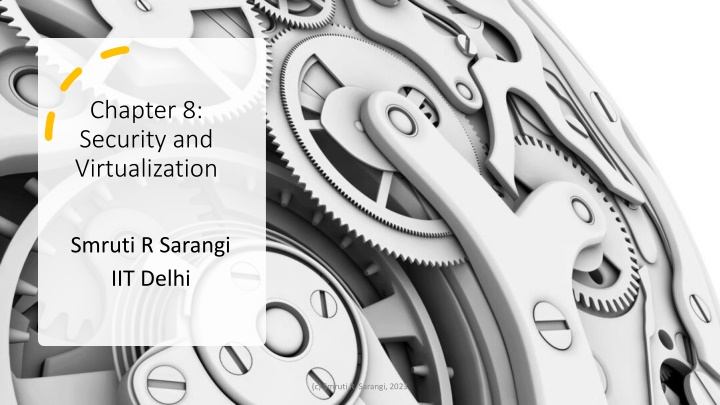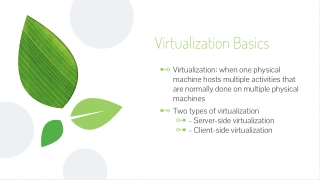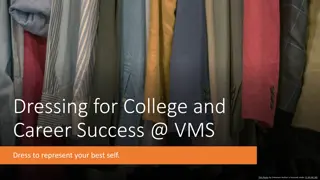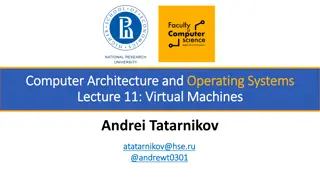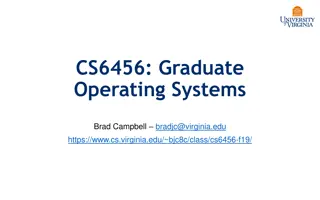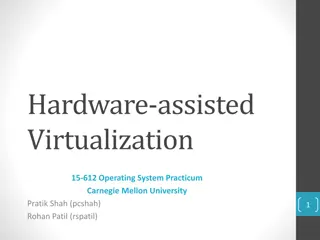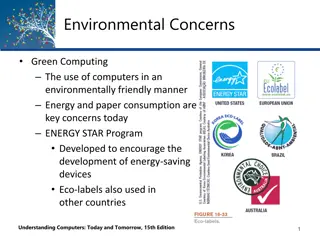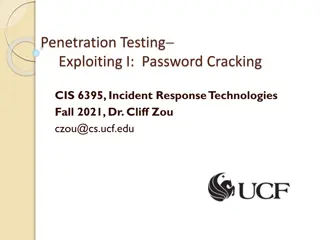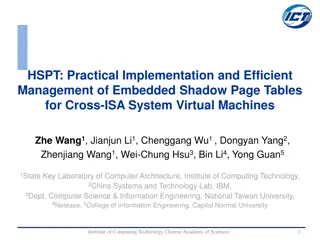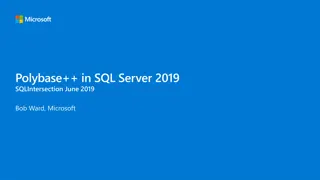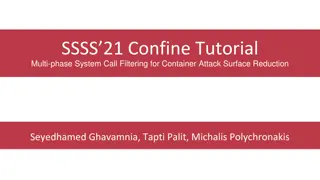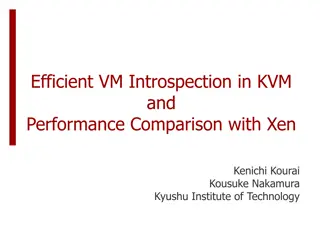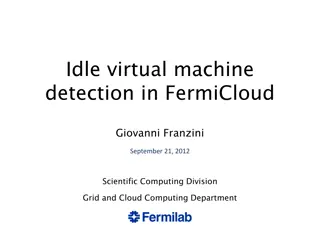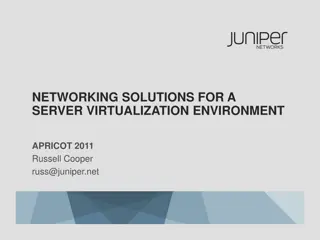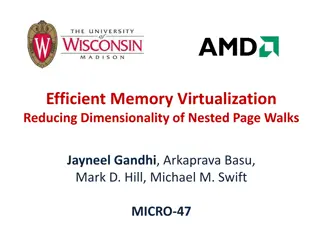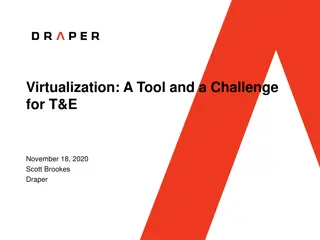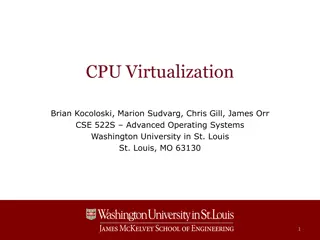Security and Virtualization: Exploring Hypervisors and VMs
Delve into the realm of security and virtualization with a focus on hypervisors, virtual machines, and their advantages in cloud environments. Understand the different types of hypervisors, virtualizing CPU, memory, and storage, along with the application of binary translation in virtualized environments. Learn about the seamless migration of VMs, benefits of server consolidation, and the concept of transparently running custom environments on any cloud machine.
Download Presentation

Please find below an Image/Link to download the presentation.
The content on the website is provided AS IS for your information and personal use only. It may not be sold, licensed, or shared on other websites without obtaining consent from the author.If you encounter any issues during the download, it is possible that the publisher has removed the file from their server.
You are allowed to download the files provided on this website for personal or commercial use, subject to the condition that they are used lawfully. All files are the property of their respective owners.
The content on the website is provided AS IS for your information and personal use only. It may not be sold, licensed, or shared on other websites without obtaining consent from the author.
E N D
Presentation Transcript
Chapter 8: Security and Virtualization Smruti R Sarangi IIT Delhi (c) Smruti R. Sarangi, 2023 1
Outline of this Chapter Virtualization Security (c) Smruti R. Sarangi, 2023 2
Run an OS as an Application processes processes processes kernel kernel kernel VM1 VM2 VM3 also known as Hypervisors Virtual machine manager (VMM) Hardware (c) Smruti R. Sarangi, 2023 3
Types of Hypervisors Type Explanation Examples Type 0 Hardware or Firmware-based VMM. Minimal software support IBM LPAR, Oracle LDOM Type 1 An OS that allows us to run other guest OSes. Provides native support and maps guest addresses to physical memory directly. Linux KVM, VMWare ESX, Citrix XenServer Type 2 Run a guest OS as a regular application VMPlayer, VirtualBox Para- virtualization The code of the guest OS is changed (unlike the previous cases) and made VM aware Xen (c) Smruti R. Sarangi, 2023 4
Advantages of VMs in Cloud Environments Create custom environments Create custom environments (OS + libraries + software) and run them on any machine on a cloud. Virtualize the CPU, network, file system, memory, and hardware Transparently migrate the VM across different types of machines Server consolidation Live migration of VMs, efficiently heterogeneous server resources (c) Smruti R. Sarangi, 2023 5
Virtualization CPU Memory i/o storage The guest OS has no idea that it is running on a hypervisor. The OS needs to think that it exclusively owns these devices (c) Smruti R. Sarangi, 2023 6
Application Ring 3 Ring 2 Virtualize the CPU Ring 1 guest OS Ring 0 Ring 0 Ring 0 Ring 0 kernel Regular instructions Trap and emulate: The guest OS runs with user privileges. Invoking a privileged inst. leads to a trap. The hypervisor catches it and successfully emulates the instruction. Privileged instructions Instructions that execute differently based on the privilege level Binary translation (c) Smruti R. Sarangi, 2023 7
Binary Translation The hypervisor follows a read-ahead scheme. Whenever a new code page is accessed, a fault is generated (either the TLB entry is missing or the page is marked non-accessible) The hypervisor reads the page and a few more subsequent pages It scans all the instructions. If there is a sensitive instruction (changes its behavior based on the privilege level), replace it with an alternative sequence Make it generate a trap or make the behavior the same (guest & kernel) (c) Smruti R. Sarangi, 2023 8
What about memory? Type 1 Hypervisors Type Explanation Guest Application GVA Guest virtual addr. TLB entry GPA HVA Guest physical addr. Host virtual addr. Guest OS GVA HPA Host OS HPA Host physical addr. Nested paging Shadow paging 1. TLB miss walk the guest and host page tables. (slow) 2. No need to track guest page table modifications. 3. VMM maintains only 1 page table. 1. The VMM builds a GVA HPA page table (one per guest process). 2. Keeps the shadow page table consistent with both page tables. TLB Miss: Access just the shadow page table (fast) 3. Track every guest page table update (c) Smruti R. Sarangi, 2023 9
I/O Virtualization One network card appears as several virtual network cards (one for each VM) Emulation: The hypervisor traps every I/O instruction and memory-mapped ld/st instruction (make pages non-accessible). Follows the trap-and-emulate method. Every guest OS uses emulated devices. [slow] With H/W support (PCI-X devices): Use the SR-IOV and MR-IOV protocols. A single device exposes separate buffers (request queues), interrupts and DMA streams to each VM. MR-IOV allows sharing the resources with multiple computers. (c) Smruti R. Sarangi, 2023 10
Paravirtualization Why not modify the guest operating system to make it VM aware? Xen [1] was the first popular para-virtualized hypervisor. Guest OSes communicate via system calls (also known as hypercalls). Avoid instructions that change their behavior based on the privilege level Ensure that either all privileged instructions either trap in VM mode or are replaced with non- privileged variants that do the same job (may invoke VMM routines) Use fast exception handlers that are directly registered in the CPU s exception and system call table. Page fault handlers need to be there with Xen (HW reasons Guest OSes can directly write into the CR3 register and change the current page table address (mapping: GVA HPA). Updates to the page table need to go through the hypervisor. Xen maintains a shadow page table for each process and it updates it when the guest OS lets it know. Interrupts are sent as lightweight events to the guest OS (similar to signals) I/O: Create a bounded queue (request buffer) between the guest OS and Xen (aka I/O ring because it is a circular queue). ) (c) Smruti R. Sarangi, 2023 11
HW-Assisted Virtualization Intel VT-x AMD-V Event Action Privileged instruction execution Most of the time it is allowed like syscall enter and exit because in this case, VMs run in Ring 0 (albeit in non-root mode or VM mode). Some I/O instructions necessitate a VM exit. The device needs to be emulated. Memory accesses Use shadow page tables that are directly stored in HW (fast path). The CPU walks both the guest and host page tables on a TLB miss and updates the shadow page table (if there has been an update to either page table, slow path). Use the SR-IOV and MR-IOV protocols I/O Storage The hypervisor maintains a guest-to-host block table. (c) Smruti R. Sarangi, 2023 12
Bibliography 1. Paul Barham, Boris Dragovic, Keir Fraser, Steven Hand, Tim Harris, Alex Ho, Rolf Neugebauer, Ian Pratt, and Andrew Warfield. 2003. Xen and the art of virtualization. In Proceedings of the nineteenth ACM symposium on Operating systems principles (SOSP '03). Association for Computing Machinery, New York, NY, USA, 164 177. https://doi.org/10.1145/945445.945462 (c) Smruti R. Sarangi, 2023 13
srsarangi@cse.iitd.ac.in (c) Smruti R. Sarangi, 2023 14
